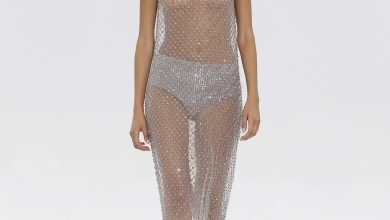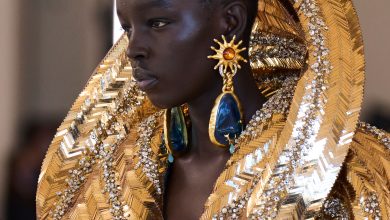Lauren Chan, Henning Founder, On Why Plus-Size Fashion Is Viable

[ad_1]
So why aren’t more companies succeeding?
In 2018, when I was starting my business, Henning, I had a meeting with a potential investor who told me that there was very little blue sky (that’s venture-capital-speak for “market opportunity”) left within plus-size fashion because three companies had already received funding. Yes, three. “Thanks for the advice re: ‘remaining blue sky,’” I wrote back. The truth: It was bullshit — grin-and-bear-it, white-knuckle, eye-roll kind of bullshit.
RELATED: The Ultra-Mini Skirt is Back. But Where’s the Body Inclusivity?
As someone who had worn above a size 14 for a decade, I was incensed. And thanks to my time as a fashion editor reporting on size inclusion, I knew that statistically I had every right to be. Nearly 70 per cent of women wear size 14 or up, and size 18 is the average size; despite those numbers, fashion largely stops at size 12 and plus-size fashion makes up less than a fifth of apparel sales. Translation: Over 100 million plus-size shoppers — including me — are without sufficient clothing options. Three? Not even close to enough.
What our limited shopping destinations do offer us is, frankly, dismal. If you’re a plus-size shopper, you know that our clothing options are mostly dowdy, outdated and cheaply made. If you’re new here, take my very exasperated word for it. Over the years, brands (think Loft, Melissa McCarthy Seven7 and even Addition Elle) have tried to improve the plus-size shopping space, but few have succeeded in the long run. And don’t get me started on the extensive list of designer brands that haven’t even tried.
During my time as an editor, I set out on a quest to uncover why fashion kept missing the mark on this obvious business opportunity. I found that there were two types of companies within this research: brands that were already size inclusive or genuinely wanted to be and those that were not and had no such aspiration. Those that weren’t size inclusive but wanted to be were often veteran brands that were unable to efficiently innovate or new brands overcome with industry-wide disadvantages. Those that didn’t want to be size inclusive simply did not want plus-size people wearing their clothes. (Sometimes, though, they got sold on the white space in the plus-size category as an easy money grab. They would then launch a disappointing plus-size effort, and when it didn’t turn to gold overnight, they gave up. The boldly fatphobic brands simply cited those failures and insisted that plus-size fashion was a dead end.)
I didn’t believe that plus-size fashion was such an impossible category, so I decided to take matters into my own hands and build my brand: Henning. My mission was twofold: Make more ethical, elevated, high-quality clothing than had ever been on offer for plus-size shoppers and prove that plus-size fashion is a viable business. Building my company was not without its challenges — any fashion-brand founder will tell you that it’s an excruciating undertaking — but a lifetime of frustration motivated me to keep on.
First, there were issues that our team was able to overcome simply by strategizing, such as the aforementioned absence of investment, a lack of skilled pattern makers due to inadequate education in size-inclusive design, mills that didn’t cut fabrics wide enough for plus-sizes, factories that hadn’t made garments above size 14, retail partners that hadn’t carried significant plus-size assortments in-store and expensive niche-customer acquisition costs. And when it came to the commonly cited additional costs involved in making plus-size clothing, we — shocker! — built them into our price margin.
Then there were the challenges that had to be handled with nuance and care. The biggest? Plus-size consumers are used to poor-quality products, downmarket branding, wallflower designs, inconsistent sizing and dismissive treatment. There is a subset of young customers who came of age during the commercialization of body positivity and shop eagerly, but many older shoppers had been ever-excluded to the point of disengagement — they hold much of our demographic’s spending power, and getting them to shop in an engaged way can be difficult.
We had a number of ideas to overcome this hurdle. For starters: Six months ahead of our product launch, we created an Instagram account to show the brand-building process, opened a private Facebook group wherein community members could interact with one another, sent out educational newsletters in which customers could reply to me directly and held in-person events and focus groups. With these efforts, we wanted to show our customers that Henning would be unlike any shopping experience they’d ever had before.
Another goal of these initiatives was to make our business operate on a two-way street, since another issue that plagues plus-size fashion is that brands don’t often listen to their customers. Throughout the life of the business, we asked them about everything from their trim preferences to bicep measurements to colour choices — and really implemented the feedback — in order to ensure the best product-market fit.
The last challenge I’ll mention is that clothing isn’t actually designed to fit people individually; it’s made to fit average measurements, and this is a status-quo issue that plus-size customers bear the brunt of. With folks who wear size 14 and up, bodily projections vary more drastically, making it harder for off-the-rack garments to fit us. Most of the plus-size market solves this issue by making super-stretchy or extremely baggy clothing. In order to avoid compromising the integrity of our suiting-focused designs, we chose tailoring. Specifically, we offered free alterations up to a value of 10 per cent of the garment cost to make sure each customer had clothes that fit perfectly, which also curbed returns.
In my humble opinion, our key to success was the shared lived experience that my team and I had with our customers. We deeply understood the intricacies of the plus-size community’s pains and hopes and were therefore able to make decisions that resonated with customers. My number one piece of advice to anyone hoping to find success in this category: Hire and give real power to plus-size people.
So why take my advice over, say, that venture capitalist’s? I’m proud to report that earlier this year Henning was acquired by the most size-inclusive brand in the world: Universal Standard. When the deal went through, it made Henning the first non-venture-backed, female-founded plus-size brand to make a successful exit. I felt immense pride and, toward the early doubters, defiance. I captioned my Instagram (@lcchan) post sharing the announcement for them: “I never want to hear anyone say that plus-size fashion isn’t a viable business ever again. [Mic drop.]”
This article first appeared in FASHION’s September 2023 issue. Find out more here.
[ad_2]
Source link






